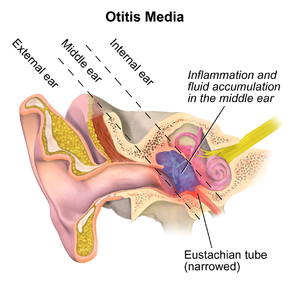Introduction
- Otitis media is an infection of the middle ear, which is the space behind the eardrum that contains the small bones of hearing.
- Otitis media can be classified into two types: acute otitis media (AOM) and otitis media with effusion (OME).
- AOM is a rapid onset of inflammation and infection of the middle ear, usually caused by bacteria or viruses.
- OME is a collection of fluid in the middle ear without signs of infection, usually due to impaired drainage of the eustachian tube.
- Otitis media is one of the most common childhood infections and a leading cause of antibiotic use in children.
- Otitis media can cause pain, fever, hearing loss, speech delay, and complications such as mastoiditis, labyrinthitis, meningitis, and cholesteatoma.

Nursing Test Bank
Quiz #1: RN Exams Pharmacology Exams
Quiz #2: RN Exams Medical-Surgical Exams
Quiz #3: RN Exams Fundamentals Exams
Quiz #4: RN Exams Maternal-Newborn Exams
Quiz #5: RN Exams Anatomy and Physiology Exams
Quiz #6: RN Exams Obstetrics and Pediatrics Exams
Quiz #7: RN Exams Fluid and Electrolytes Exams
Quiz #8: RN Exams Community Health Exams
Quiz #9: RN Exams Promoting Health across the lifespan Exams
Quiz #10: RN Exams Multidimensional care Exams
Naxlex Comprehensive Predictor Exams
Quiz #1: Naxlex RN Comprehensive online practice 2019 B with NGN
Quiz #2: Naxlex RN Comprehensive Predictor 2023
Quiz #3: Naxlex RN Comprehensive Predictor 2023 Exit Exam A
Quiz #4: Naxlex HESI Exit LPN Exam
Quiz #5: Naxlex PN Comprehensive Predictor PN 2020
Quiz #6: Naxlex VATI PN Comprehensive Predictor 2020
Quiz #8: Naxlex PN Comprehensive Predictor 2023 - Exam 1
Quiz #10: Naxlex HESI PN Exit exam
Quiz #11: Naxlex HESI PN EXIT Exam 2
Questions on Introduction
Correct Answer is B
Explanation
The statement that "The risk factors for otitis media are not well-defined" is incorrect.
The risk factors for otitis media are well-established, including factors like age (more common in children), exposure to smoke, attending daycare, and Eustachian tube abnormalities.
Correct Answer is D
Explanation
Passive smoking can increase the risk of otitis media.
Exposure to secondhand smoke can cause irritation and inflammation in the Eustachian tubes, making individuals, especially children, more susceptible to ear infections.
Correct Answer is ["A","B","C"]
Explanation
The statement about the eardrum becoming red, swollen, and bulging due to the absence of effusion is incorrect.
The presence of effusion behind the eardrum can cause it to appear red, swollen, and bulging, not the absence of effusion.
Correct Answer is C
Explanation
Skin rashes and allergic reactions are not mentioned as consequences of otitis media.
Complications of otitis media primarily revolve around the auditory system and related functions.
Correct Answer is D
Explanation
Day care attendance is closely associated with an increased exposure to infectious agents, including the bacteria that can cause otitis media.
Children in day care settings are in close contact with others, facilitating the spread of infections.
Correct Answer is ["B","D"]
Explanation
Otorrhea, which refers to discharge from the ear, is not a common symptom of AOM.
Otorrhea is more commonly associated with chronic ear infections or other ear conditions but not necessarily with acute otitis media.
Correct Answer is A
Explanation
Immunization history of the child is important for the child's overall health, but it is not a specific symptom of otitis media.
Immunizations do not directly influence the development or presence of otitis media.
Correct Answer is ["A","B","C","E"]
Explanation
Decreased mobility of the tympanic membrane can occur due to the accumulation of fluid in the middle ear, leading to impaired movement.
This decreased mobility is often observed in acute otitis media and contributes to the diagnosis.
The eardrum appearing red and bulging is a typical finding in acute otitis media (AOM), not otitis media with effusion (OME).
In AOM, the eardrum becomes red due to inflammation and bulges due to increased pressure from fluid buildup.
Inconsolable crying due to discomfort is a general symptom that can occur in children with various illnesses, including otitis media.
While it indicates the child is in pain or discomfort, it is not a specific sign of hearing loss.
Children may cry due to ear pain, but this symptom alone does not co
"I have no pain in my ear.”.
Absence of ear pain is not consistent with otitis media.
Otitis media is characterized by ear pain, especially in acute cases when there is inflammation and pressure in the middle ear.
Lack of ear pain suggests the absence of this condition.
"I don't have a fever at all.”.
The absence of fever is not consistent with acute otitis media.
Fever is a common systemic response to infection and inflammation.
In the context of otitis media, the presence of fever indicates a more severe or active infection.
Lip reading skills are not typically assessed in the context of otitis media.
Otitis media primarily affects the auditory system, leading to hearing difficulties.
While lip reading skills might be relevant for individuals with profound hearing loss, it is not a standard assessment for children with
The statement "I can balance perfectly" suggests that the child does not experience balance problems.
This statement contradicts the typical symptoms associated with otitis media, which can include dizziness, unsteadiness, and balance issues.
If the child can balance perfectly, it indicates that the
No explanation
Search Here
Related Topics
- Stages of physical, cognitive, social and emotional development from infancy to adolescence - Common Pediatric Conditions
- Developmental milestones and screening tools - Common Pediatric Conditions
- Factors affecting growth and development - Common Pediatric Conditions
- Interventions to promote optimal development - Common Pediatric Conditions
- Conclusion - Common Pediatric Conditions
More on Nursing
Free Nursing Study Materials
Access to all study guides and practice questions for nursing for free.
- Free Nursing Study Trials
- Free Nursing Video tutorials
- Free Nursing Practice Tests
- Free Exam and Study Modes
- Free Nursing Revision Quizlets
